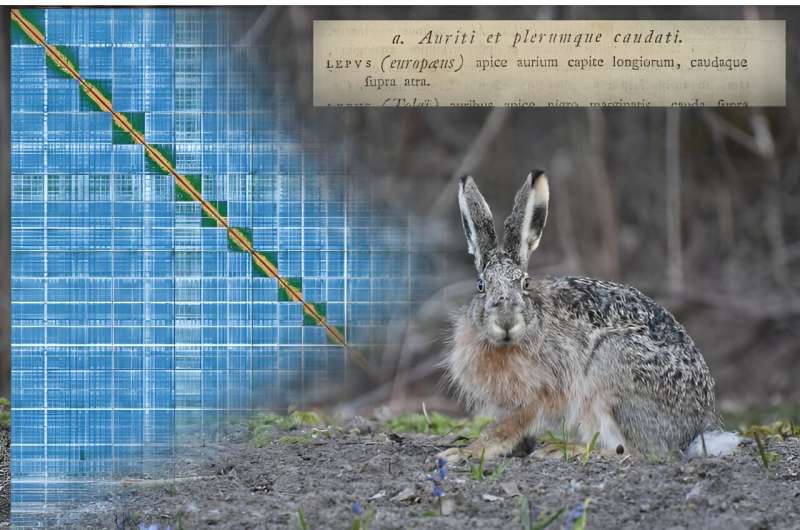
Credit: Peer Community Journal (2024). DOI: 10.24072/pcjournal.393
The Hare Research Group at the Department of Environmental and Biological Sciences, University of Eastern Finland, has published a chromosomally assembled reference genome for the European brown hare. Reference genomes represent a type of a standard for the species genomes, to which any genomic data from the species can be compared.
The team has also published an article on their research in the Peer Community Journal.
Traditionally, assembling reference genomes has been very difficult, as they have required constructing cytogenetic and linkage maps of chromosomes, which is why they have been available only for humans and for some well-known model organisms in used in research.
However, recent technological advances have enabled new methods to reconstruct chromosome structures and identify their gene contents. These methods were also utilized in this study to sequence and assemble a reference genome of a brown male hare from Liperi, Eastern Finland.
The genome consists of 2.9 billion base pairs, which form 23 autosomal chromosomes, and X and Y sex chromosomes. In total 30,833 genes were identified, of which 21,467 are protein encoding. As a comparison, the human genome is slightly bigger (3.1 billion bases) but has fewer protein coding genes (20,080).
The brown hare represents the first genome of a Finnish species in the European Reference Genome Atlas initiative, which aims to generate reference genomes for all European eukaryotic species.
The reference genome enables and facilitates many types of research with the species in the future, as any DNA sequence data from the species can be rapidly identified by comparing it with the reference. In addition, researchers can seek and identify any interesting parts of the genome, such as individual genes and use these to plan and conduct research.
Together with the mountain hare reference genome that is currently under preparation, the brown hare genome has already opened new research avenues into evolutionary history, physiological adaptations and population surveys. Openly accessible genome data and related research will also accelerate development in the field, generating new knowledge, practical applications and innovations.
The timing of the genome release is very appropriate as the brown hare also represents the original Easter Bunny familiar from European folklore. While there are conflicting accounts for the origins and symbolism of the Easter Bunny, brown hares were common in mainland Europe long before rabbits—originating from the Iberian Peninsula—became popular.
More information:
Reference genome for the European brown hare: www.ncbi.nlm.nih.gov/genome/gd … /?id=GCF_033115175.1
Craig Michell et al, High quality genome assembly of the brown hare (Lepus europaeus) with chromosome-level scaffolding, Peer Community Journal (2024). DOI: 10.24072/pcjournal.393
Citation:
Decoding the Easter Bunny: Eastern Finnish brown hare represents standard for species’ genome (2024, March 20)
retrieved 20 March 2024
from https://phys.org/news/2024-03-decoding-easter-bunny-eastern-finnish.html
This document is subject to copyright. Apart from any fair dealing for the purpose of private study or research, no
part may be reproduced without the written permission. The content is provided for information purposes only.
>>> Read full article>>>
Copyright for syndicated content belongs to the linked Source : Phys.org – https://phys.org/news/2024-03-decoding-easter-bunny-eastern-finnish.html










